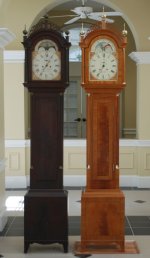Well there you have it HS.
White or yellow glue and clamps (not reversible but you have everything at hand)
Liquid Hide glue and clamps (reversible, glue doesn't creep, probably need to go get liquid hide glue, Your hardware store probably has Franklin's, call ahead to be sure)
Hot hide glue (doesn't creep, don't need clamps, need to get or make a veneer hammer, need a glue pot{small crock pot, coffee warmer, Hold Heet glue pot, about 140 degrees F} glue granules. There is a learning curve.
Vacuum Bag. I was being a bit facetious here but it is a method, albeit expensive. (doesn't creep, no need for clamps, need to get vacuum pump, bag, 2 part glue)
I see knowing how to use hide glue as a great benefit to period furniture making. Rub joints, glue blocks, veneering. It is reversible, accepts stain,
here is a link to This Years Cartouche winner! Patrick Edwards article from the APF
http://www.wpatrickedwards.com/gluearticle.htm
and also a WoodTreks video of Patrick Edwards on Hide glue
http://woodtreks.com/learn-how-hammer-veneers-hand-tools-inlay-marquetry-hide-glue/1493/
Elwood Blues: This is glue. Strong stuff.

